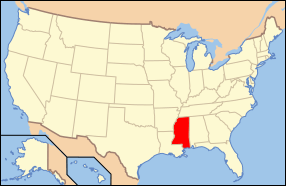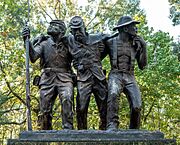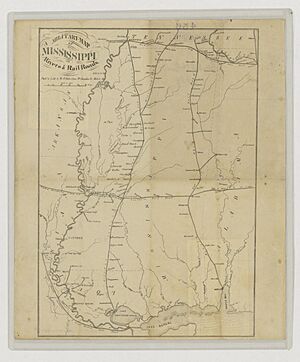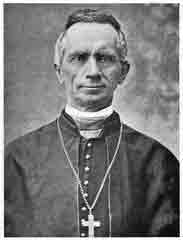Mississippi in the American Civil War facts for kids
Quick facts for kids Mississippi |
|||||
|---|---|---|---|---|---|
| Nickname(s): "The Magnolia State" | |||||
|
|||||
| Capital | Jackson | ||||
| Largest City | Natchez | ||||
| Admission to confederacy | March 29, 1861 (5th) | ||||
| Population |
|
||||
| Forces supplied |
|
||||
| Major garrisons/armories | Corinth | ||||
| Governor | 1859–1863 John J. Pettus 1863–1865 Charles Clark |
||||
| Senators |
|
||||
| Representatives | List | ||||
| Restored to the Union | February 23, 1870 | ||||
Mississippi was the second southern state to leave the United States. This happened on January 9, 1861. It then joined six other southern states to form the Confederacy on February 4, 1861.
Mississippi's location along the long Mississippi River was very important for both the Union (the North) and the Confederacy (the South). Many battles were fought in the state. Armies often clashed near important towns and travel routes.
Mississippi troops fought in all the main parts of the American Civil War. However, most of them were in the Western part of the war. Jefferson Davis, who became the Confederate president, was a politician from Mississippi. He also owned a large cotton farm there. Some important generals from Mississippi during the war included William Barksdale, Carnot Posey, Wirt Adams, Earl Van Dorn, Robert Lowry, and Benjamin G. Humphreys.
| Top - 0-9 A B C D E F G H I J K L M N O P Q R S T U V W X Y Z |
Why Mississippi Left the Union: Secession
Before the American Civil War, Mississippi was a state where slavery was common. People there mostly voted for the Democrats. In the 1860 election, Mississippi supported John C. Breckinridge, a Southern Democrat. He received about 59% of the votes.
Abraham Lincoln, who won the national election, was not even on the ballot in Mississippi. Many people in Mississippi strongly believed in leaving the Union. They also supported slavery and states' rights.
Mississippi decided to leave the United States on January 9, 1861. This was two months after the Republican Party won the U.S. presidential election. Less than a month later, Mississippi joined the Confederacy. They wrote a statement explaining why they left. It said their reason was "thoroughly identified with the institution of slavery." They called slavery "the greatest material interest of the world."
Fulton Anderson, a lawyer from Mississippi, spoke to Virginia's secession meeting in 1861. He said that the "grievances of the Southern people on the slavery question" were the main reason. He also mentioned their opposition to the Republican Party's goal of ending slavery.
Judge Alexander Hamilton Handy from Mississippi agreed. He believed the Republican Party would try to stop slavery in new areas. He thought this would make slavery seem like a "sin." He felt this would threaten the rights of the South.
In 1860, Mississippi was one of only two states where most of the people were enslaved. The other was South Carolina. Jefferson Davis, a future Confederate leader, said Mississippi joined the Confederacy because it felt threatened. He said the idea that "all men are created free and equal" was a danger to slavery. He also said the "Declaration of Independence" was used to support "equality of the races," which he did not agree with.
William L. Harris, a Mississippi official, told Georgia's assembly that Republicans wanted "equality between the white and negro races." He said secession was needed for slave states to fight this.
Joining the Fight: Enlistment
There were a few people in Mississippi who supported the Union. The most famous group was "The Free State of Jones" in Jones County. This group was led by Newton Knight.
But most white Mississippians supported slavery and the Confederate cause. Thousands joined the Confederate military. About 80,000 white Mississippians fought for the Confederate Army. Around 545 white Mississippians joined the Union Forces.
As the war continued, many enslaved people who were freed or escaped joined the United States Colored Troops. These were black regiments fighting for the Union. More than 17,000 black Mississippians, both enslaved and free, fought for the Union.
Most soldiers were volunteers. Men who owned more property, including enslaved people, were more likely to volunteer. Poorer men were less likely to join. Men living near the Mississippi River were also less likely to join the army. Many military-age men in these western counties moved away. The Union controlled the Mississippi River, making areas near it very dangerous. People living there often left their homes rather than face invasion.
Ending Slavery: Emancipation
On January 1, 1863, the Emancipation Proclamation went into effect. Parts of northwestern Mississippi were already controlled by the Union. The Proclamation declared all of Mississippi "in rebellion." So, Union forces began freeing enslaved people in the areas they controlled right away.
A Confederate lieutenant from Mississippi said that slavery was the reason his state left the Union. He stated, "This country without slave labor would be completely worthless... We can only live & exist by that species of labor: and hence I am willing to fight to the last."
Mississippi Towns During the War
Corinth: A Key Railroad Hub
Corinth was very important because two railroads met there. Confederate General P. G. T. Beauregard retreated to Corinth after the Battle of Shiloh. Union General Henry Halleck followed him. Beauregard left the town when Halleck got close, and Corinth fell to the Union. Halleck moved very carefully, digging trenches for over a month. This action is known as the Siege of Corinth.
The Second Battle of Corinth happened on October 3–4, 1862. Confederate General Earl Van Dorn tried to take the city back. His troops won the city but were soon forced out when Union reinforcements arrived.
Oxford: Burned to the Ground
On August 22, 1864, the city of Oxford, Mississippi, was burned down by Union General Andrew Jackson Smith. Only the University of Mississippi and two shops were left. This happened because Confederate General Nathan Bedford Forrest had taken shelter in Oxford.
Jackson: The Capital Under Attack
Even though it was small, Jackson was a key manufacturing center for the Confederacy. In 1863, Union forces captured Jackson twice. This happened during the campaign that led to the capture of Vicksburg.
On May 13, 1863, Union forces won the first Battle of Jackson. Confederate forces had to flee north. Union troops under William Tecumseh Sherman then burned and looted important buildings in Jackson. After pushing the Confederates out, Union forces moved west to besiege Vicksburg.
Confederates gathered again in Jackson to try and break the siege at Vicksburg. They marched out in early July. But they did not know that Vicksburg had already surrendered on July 4. Union General Ulysses S. Grant sent Sherman to meet the Confederate forces. When the Confederates learned Vicksburg had fallen, they retreated back to Jackson. This started the Siege of Jackson, which lasted about a week before the town fell again.
Edwards: A Retreat Point
On May 17, 1863, Confederate soldiers retreated through a place called "Askew's Landing." This was after they lost the Battle of Champion Hill. They quickly used Askew's Ferry to cross the river and then burned it. This was to stop the Union Army from following them.
Skirmishes also happened at the Bridgepoint Plantation. Union forces pursued Confederate soldiers there. Later, in June of the same year, another skirmish took place at the plantation. Today, the battle site is open to the public as a campground.
Natchez: A City Spared
During the Civil War, the city of Natchez was mostly undamaged. The city surrendered to Union Flag-Officer David Farragut in May 1862. This happened after New Orleans fell. Union soldiers from Vicksburg occupied Natchez in 1863.
The local Union commander, General Thomas Ransom, set up his headquarters at a home called Rosalie. Some people in Natchez showed they did not support the Union. In 1864, the Catholic bishop, William Henry Elder, refused to make his church members pray for the U.S. president. Union forces arrested him and jailed him briefly.
After the war, white Natchez became more supportive of the Confederacy. The "Lost Cause" idea grew. This was a way for people to deal with the Confederacy's defeat. It became a strong belief, supported by celebrations, speeches, and statues. Women in Natchez were especially important in keeping this idea alive. They helped set up memorials, like the Civil War Monument in 1890.
Vicksburg: A Decisive Union Victory
Vicksburg was the site of the Siege of Vicksburg. This was a huge victory for the Union. It gave them control of the entire Mississippi River. This cut off the western Confederate states. The battle was a long siege because the town was on high ground and well protected.
Life for civilians was very hard during the siege. There was heavy shelling and starvation. About 30,000 Confederates surrendered. Instead of being sent to prison camps, they were sent home. They were told they could not fight again until they were officially exchanged for Union prisoners.
Greenville: A Supply Hub and Target
Greenville was a key village for Union General Grant's operations in Mississippi. The area around Greenville supplied Vicksburg's military with food and animals. In March 1863, General Frederick Steele led an expedition to Greenville. His goal was to find a route to Vicksburg and to harm Confederate forces and landowners.
Steele's men took almost 1,000 animals and burned 500,000 bushels of corn. They also gained several hundred enslaved people who wanted to escape slavery. These people followed the troops to Greenville. General Grant decided that any enslaved people who wanted to could join the U.S. Army. The first black regiments were formed during this expedition. By the end, nearly 500 former enslaved people were training to be soldiers.
Steele's actions in Greenville drew the attention of Confederate leaders away from Union movements. This was important because it cut off vital supplies for Vicksburg. In May, Union Navy Commander Selfridge ordered his men to burn homes and buildings of citizens who helped Confederates. On May 9, large plantations were destroyed. The destruction of Greenville was completed on May 6. Union soldiers burned almost every building in the village, leaving only two.
Choctaw County: Union Supporters
During the war, some people in Choctaw County supported the Union. They formed a "Loyal League." This group worked with the U.S. to "break up the war." They encouraged soldiers to leave the army and helped Union authorities.
Other Important Towns
Columbus was an important hospital town early in the war. It also had a factory that made gunpowder, cannons, and handguns. Union forces targeted Columbus twice, but they failed to attack it because of Nathan Bedford Forrest and his men. Many soldiers wounded at the Battle of Shiloh were brought here. Thousands were buried in the town's Friendship Cemetery.
Canton was an important railroad and supply center. Many wounded soldiers were treated or moved through the city. It also has a large Confederate cemetery.
Meridian was important because it was a major railroad junction. It had a Confederate factory, a military hospital, and a prisoner-of-war camp. In February 1864, Union forces under Sherman reached Meridian. They destroyed the railroads and burned much of the area. Sherman is said to have declared, "Meridian no longer exists."
A temporary shipyard was built on the Yazoo River at Yazoo City. This happened after the Confederates lost New Orleans. Union forces destroyed the shipyard in 1863. Yazoo City then fell back to Confederate control. Union forces took the city again the next year and burned most of its buildings.
Major Battles in Mississippi
- Skirmish at Aberdeen
- Battle of Big Black River Bridge
- Battle of Booneville
- Battle of Brices Cross Roads
- Battle of Champion Hill
- Battle of Chickasaw Bayou
- Siege of Corinth
- Battle of Corinth
- Battle of Grand Gulf
- Battle of Iuka
- Battle of Jackson
- Battle of Meridian
- Battle of Okolona
- Battle of Oxford
- Battle of Port Gibson
- Battle of Raymond
- Burning of Seminary
- Battle of Senatobia
- Battle of Snyder's Bluff
- Battle of Tupelo
- Siege of Vicksburg
Mississippi Returns to the Union
After the war, during the Reconstruction period, Mississippi was part of the Fourth Military District of the U.S. Army. This district was commanded by generals like Edward Ord, Alvan Cullem Gillem, and Adelbert Ames. Mississippi officially rejoined the Union on February 23, 1870.
See also
- Confederate States of America - animated map of state secession and confederacy
- List of Mississippi Civil War Confederate units
- List of Mississippi Union Civil War units
- Mississippi Secession Ordinance
- History of slavery in Mississippi







